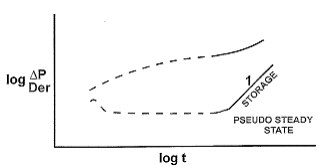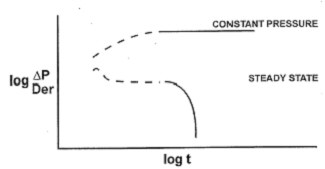Pseudo-Time
Subtopics:
Effect of Applying Pseudo-Time
Pseudo-time is a mathematical time function that accounts for the variable compressibility(ct) and viscosity (mg) of gas, as well as the variable total (formation) porosity (f) with respect to time and pressure.
Why Use Pseudo-Time?
The equation for flow of gas in the reservoir is very similar to that for liquid flow. In well testing, analytical equations are solved after making certain assumptions. In particular, four assumptions are very important:
1. Total system compressibility (ct) is constant
2. Gas viscosity (mg) is constant
3. Total porosity (f) is constant
4. Fluid saturations (Sg and Sw) are constant
For liquids, these assumptions are reasonable, since liquid compressibility and viscosity do not vary significantly with pressure, and the equations can be solved analytically. These analytical solutions are referred to as the liquid flow solutions, and form the basis of all well test analysis. The result is an analytical relationship between pressure and time, which, for an infinite-acting reservoir, can be written as
Pressure = Constant * log (time) + ...
For gas, most of the assumptions listed above are no longer valid. Gas compressibility (cg) varies significantly with pressure. Gas viscosity (mg) and Gas Compressibility Factor also vary with pressure but not to the same degree. Pseudo-pressure and pseudo-time (ta) are used to deal with these changing properties and linearize the flow equations for gas. With the introduction of pseudo-pressure and pseudo-time, the gas flow equation can be written in a manner similar to the liquid equation. Therefore, the liquid flow solution can be used for gas well test analysis and forecasting provided pressure is replaced by pseudo-pressure, and time is replaced by pseudo-time as follows:
Pseudo-Pressure = Constant * log (Pseudo-time) + …
Effect of Applying Pseudo-Time
The effects of applying pseudo-time are significant for the following two conditions as shown in the subsequent plots:
- Low pressure at the wellbore
- Depleting reservoirs
The first plot shows that type curves can be inaccurate if pseudo-time is not used. The second plot shows that the buildup pressure does not reach up to the average reservoir pressure, when pseudo-time is not used. Thus, it is imperative that pseudo-pressure and pseudo-time be used for accurate analysis, modeling, and forecasting of gas production.


Development of Pseudo-Time
It should be noted that the concept of pseudo-time is not amenable to a completely rigorous solution, as is the case for pseudo-pressure, because the gas properties change with pressure, not time. The form of the diffusivity equation dictates which properties are grouped with pressure and which are grouped with time.
Pseudo-time was developed by Agarwal (1980) and he defined pseudo-time in terms of the viscosity (mg) and compressibility (ct) at the wellbore. This definition accounted for the large change in gas compressibility (cg) that occurs at low pressures (early time in a buildup). It had little effect on late time data, and was generally used for buildups only.
In the 90s, when the gas flow equations were being used for analyzing or forecasting data affected by reservoir depletion, it was realized that the Agarwal definition of pseudo-time for buildups, was inappropriate for boundary-dominated flow (depleting systems). Moreover, the Agarwal pseudo-time definition did not solve the problem, because it was using a simplified version of the total system compressibility (ct).
Blasingame et al. introduced a new definition of pseudo-time to account for the depletion effects. Instead of defining the pseudo-time transformation in terms of wellbore conditions like Agarwal did, they defined it in terms of the average reservoir pressure. This pseudo-time is best described as material balance pseudo-time, which is appropriate for boundary-dominated flow. Fekete's Rahman, Mattar, and Zaoral showed that a rigorous definition of compressibility, which uses material balance principles, is required because fluid saturations can change over time. Fekete's Anderson and Mattar found that, in a reservoir with significant transient flow, it was more appropriate to define pseudo-time in terms of the average pressure within the region of investigation, rather than the average reservoir pressure.
Two different pseudo-time formulations are needed: one for buildup and a different one for drawdown. The equations look similar, but they are radically different from each other.
Definition of Pseudo-Time
Pseudo-time (ta) is defined as:
Note that the units for this definition of pseudo-time are hr/cp psi-1. In order to convert this unit to hr, the integral is multiplied by mgi cti to obtain normalized pseudo-time as follows:
Thus, the subsequent definitions of buildup and drawdown pseudo-time presented below used this normalized form.
Buildup Pseudo-Time
Pseudo-time for use in buildup analysis, is defined in terms of pressure at the wellbore:
If the wellbore has significant storage, a difference in the early time behaviour will be noted, since pressure and thus compressibility and viscosity are changing most near the wellbore. Late time behavior is not typically affected by buildup pseudo-time since the pressure, viscosity, and compressibility become constant at the wellbore and in the reservoir.
Drawdown Pseudo-Time
Pseudo-time for use in drawdown analysis, is defined in terms of average reservoir pressure:
Note that the gas in place (GIP) must be known in order to perform the material balance calculations necessary to determine the average reservoir pressure.
The analytical models in the Advanced Models tab in WellTestTM have an option to use Corrected pseudo-time. This option uses the definition of drawdown pseudo-time that is based on the average pressure within the region of investigation, rather than the average reservoir pressure. This is the default setting, which we recommend you keep as is.
Agarwal suggested that the total system compressibility (ct) be defined as:
Where the compressibilities and saturations of residual fluids (oil (So) and water (Sw)) are considered constant. As shown by Rahman, Mattar, and Zaoral, the above definition of total system compressibility (ct) does not use the material balance equation principles in most scenarios of depletion. Therefore, a rigorous definition of total system compressibility (ct) for the purpose of computing drawdown pseudo-time has been proposed as:
Where:
By applying drawdown pseudo-time, the shape of the derivative curve in late time changes depending on the size of the reservoir. As the reservoir depletes the average reservoir pressure changes, which in turn affects the compressibility and viscosity in the late time region. Conversely, as the GIP is increased, the effect of pseudo-time becomes less noticeable (approaches real time), since average reservoir pressure approaches initial pressure and compressibility and viscosity become constant throughout the late time region.
Geomechanical effects can be modeled using pressure-dependent permeability and formation compressibility. Further adjustment to the definition of pseudo-pressure and pseudo-time are used to model these effects.
References
1. "A New Method for Computing Pseudo-Time from the Material Balance Equation for Real Gas Flow", N. M. Anisur Rahman, Louis Mattar, and Karel Zaoral, Paper CIPC 2004 - 182 presented at the CIPC, Calgary, June 8 - 10, 2004.
2. "Theory and Practice of the Testing of Gas Wells, Third Edition", Energy Resources Conservation Board (ERCB), pp. 2 -16 to 2 - 30, 1975.
3. "Real Gas Pseudo-Time - A New Function for Pressure Buildup Analysis of MHF Gas Wells", R.G. Agarwal, Paper SPE 8279 presented at AFTCE, Las Vegas, NV, September 23 - 26, 1979.
4. "The Flow of Real Gases through Porous Media", R. Al - Hussainy, H.J. Ramey, Jr., and P.B. Crawford, JPT, pp. 625 - 636, May 1966.
5. "An Improved Pseudo-Time for Gas Reservoirs with Significant Transient Flow", D. Anderson, L. Mattar, JCPT 07-07-05, July 2007.